ENVIROTHON WILDLIFE
1/11
There's no tags or description
Looks like no tags are added yet.
Name | Mastery | Learn | Test | Matching | Spaced |
|---|
No study sessions yet.
12 Terms
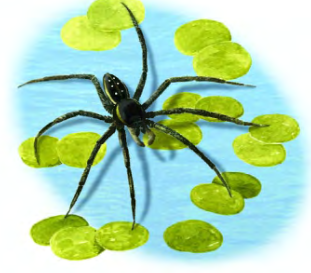
Fishing or Nursery Web Spiders
look like wolf spiders but have smaller eyes and legs spread more to the sides.
some species “fish” for prey near water
aquatic prey: insects, crustaceans, and small minnows.
stand on stream or pond banks with their legs touching the water to feel vibrations from passing prey
dive into the water to catch any detected prey
other species hunt vertically on plants or basement walls & build a “nursery” web in vegetation where they guard their egg sacs and young spiderlings
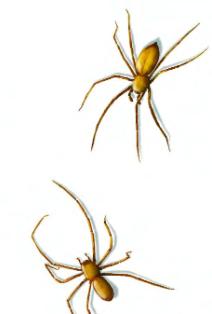
Sac Spiders
light-colored with dark fangs and visible spinnerets (silk-spinning parts)
make small silk sacs under rocks or bark for sleeping and raising young
wander through plants or homes to hunt prey
two family groups of sac spiders
two species, yellow sac spiders (Cheiracanthium mildei and C. inclusum), are the only moderately poisonous spiders found in New York
bites contain necrotic venom —> itchy or painful sores that heal slowly.
Many bites blamed on brown recluse spiders in NY are actually from yellow sac spiders.
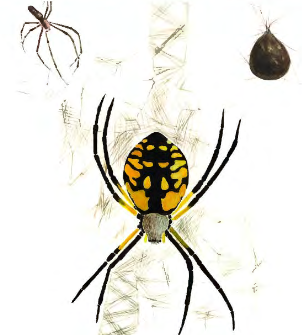
Black & Yellow Garden Spider
one of the largest and most noticeable spiders in NY
active during the day and found in sunny fields and gardens.
orb weaver: builds complex webs that extend its ability to sense and catch prey
The web includes:
Non-sticky spokes (radii) and frame lines for support
A sticky spiral that traps flying insects
White zigzag silk patterns that warn birds not to fly through
The spider rebuilds its web each morning to refresh the sticky spiral.
Large prey are wrapped in silk to keep them still.
sexually dimorphic: females are much larger than the tiny males
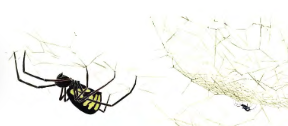
Sheet Web Weavers
very small spiders, < ¼ inch long
very common in plants and vegetation.
build fine, non-sticky, sheet-like webs in vegetation.
webs have:
A horizontal lace-like sheet
“Knock down” threads or many fine, messy vertical strands
Small flying insects can’t see these threads, crash into them, and fall onto the sheet.
The spiders run upside down under the web and bite prey through the web.
Different species build different web shapes:
The “bowl and doily” spider makes a cup-shaped web above the sheet and hangs from it.
The “filmy dome” spider builds a dome-shaped web where it hides underneath.

Harvestmen (daddy-long-legs)
not true spiders, but are related arachnids.
Harvestmen and ticks have one body segment, while spiders have two
oval bodies and long, thin legs.
omnivores: hunt small insects, scavenge dead material, and eat plant juices.
do not have venom but can produce a foul-smelling scent for defense.

Funnel Web/Grass spiders
build strong, non-sticky sheet webs on plants w/“knock down” threads on top.
One corner of the web narrows into a silken funnel, where the spider waits facing out.
When an insect lands on the web, the spider quickly runs out and bites it before it can escape.
Grass spiders are about 3/4 inch long with brown bodies and long, noticeable spinnerets.
found on low hedges or evergreen plants near buildings.
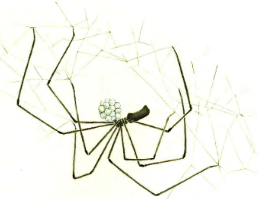
Cellar spiders
very long, thin legs and a narrow, elongated body.
hang upside down in loose, messy webs on walls near home ceilings.
After laying about a dozen eggs, the female wraps them in silk and carries the egg cluster in her fangs.
When scared, they spin quickly in their webs, becoming a nearly invisible blur.
It’s a myth that cellar spiders are highly poisonous—they are not.
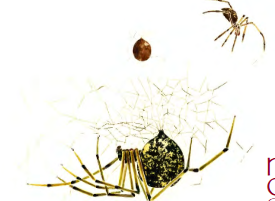
American House Spider
most common cobweb spider around homes.
have large, round, shiny abdomens and thin legs.
hang upside down in messy cobwebs attached by a few sticky threads.
webs are built in places protected from weather.
Female cobweb spiders make light brown, round egg sacs that hang in the web.
The black widow spider is also a cobweb spider, with a shiny black body and a red hourglass mark, but it is very rare in New York.
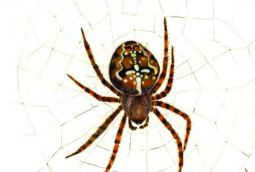
Nocturnal orb weaving spiders
active at night and build orb webs where night-flying insects like moths are common
build webs near porch lights or other bright areas
Most Araneus spiders are brown with two bumps on the front of their abdomens.
The cross spider has white spots shaped like a cross on its abdomen.
The marbled spider (A. marmoreus) has bold patterns and lives in fields, not near buildings.
During the day, these spiders hide in a retreat made from a curled leaf tied with silk.
This retreat is usually located above the old web and connected to it by a silk thread.

Jumping Spiders
large eyes, short squat bodies, and strong legs.
colorful, intelligent, and have unique personalities.
excellent vision and often look directly at people approaching.
Active during the day, they hunt insects and other spiders.
Named for their ability to jump long distances while hunting or moving through plants.
Before jumping, they attach a silk dragline to the ground as a safety line in case they miss.
If prey can’t be reached by a direct jump, they take a detour through vegetation to get above the prey.
Males court females by moving bright body parts like chelicerae, palps, or leg tufts.
In autumn, many build silken retreats in goldenrod plants, windowsills, or mailboxes.
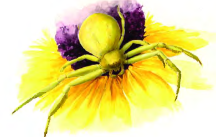
Crab Spiders
named for how they hold their legs out to the sides and walk like crabs.
Their front two pairs of legs are often much larger, enhancing the crab-like look.
do not build webs but wait still for prey to come close.
hunt on flowers, catching insects like bees, flies, and butterflies.
use fast, strong venom to quickly paralyze their prey.
Crab spiders can change color (white, yellow, or pink) over several days to match the flower they’re on.
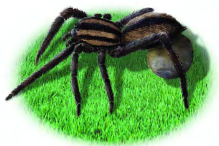
Wolf spider
Wolf spiders are slightly furry and usually brown or gray.
They have long, strong legs and good vision thanks to two large eyes among their eight.
They run after their prey instead of using webs.
Active at night, they hunt on the ground or low plants.
Female wolf spiders carry round, light-colored egg sacs attached to their spinnerets.
After hatching, spiderlings ride on their mother’s abdomen for about a week.
At night, you can spot them by shining a flashlight at ground level and looking for their eyes reflecting silvery blue-green light.